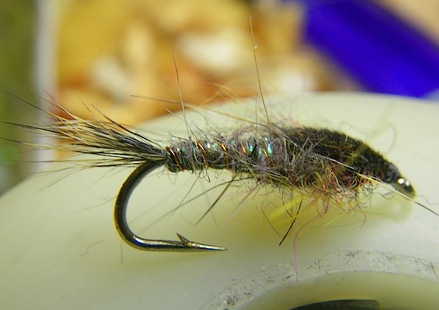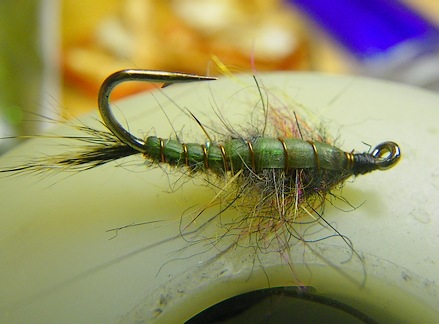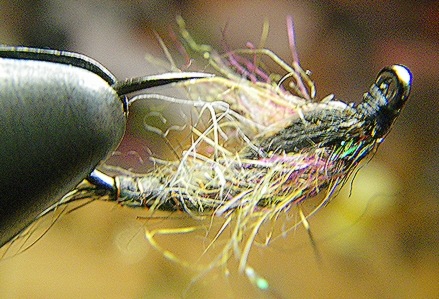 I’m minding my own business and Reed Curry plants an idea in my head that’s been gnawing at me for months:
I’m minding my own business and Reed Curry plants an idea in my head that’s been gnawing at me for months:
“What elements of a natural fly are absolutely essential for the trout brain to use…”
… to recognize food.
Better yet, what elements of a natural (or successful imitation) are essential when it’s moving at eight or ten miles an hour, in concert with millions of oxygen bubbles, scraps of moss and twigs, and the sediment your buddy upstream added?
Does a fish eating stonefly nymphs take your nymph because of its size, or because it’s both big and black? Does the grab you just missed on your Pheasant Tail mean the nymph represents the predominant hatching insect – or was it merely the closest, and the fish was bored of the olive ones ….
Hence the quandary, the simplest of all questions – and there’s no single authority to ask for a definitive answer.
Anglers never look a gift horse in the mouth, we’re free with what little fact we’ve established. Some fellow sees us playing a fish and inquires what they’re eating, and the fact that we’ve caught four on a #14 Pale Morning Dun cannot be denied. If our new found pal knots one on and scratches a fish or two, it’s unanimous, the fish are eating PMD’s …
… but are they?
Caddis are dancing under the overhanging brush, there’s something in the water column headed for the surface, and just above us could be slack water with a spinner fall.
It could be that the PMD’s are emerging upstream and only getting to the surface in the fifty yards we’re camped in – perhaps that caddis has a similar body color, and your mayfly imitation is the next best thing to Nature, accidental like …
… or maybe the outflow from the slack water is bunching the spinners into small rafts of wings and tails and the fish are keyed to anything that looks semi-edible and floats.
… but we’ll never know, as we’re intent on sliding that PMD under that big tree limb where the dimples appear larger.
I love posing the impossible question, and hate being the recipient. Friend Reed has dropped an imponderable in my lap and I can’t tease it loose.
Compounding the problem is my binocular vision, and while I can’t see as a fish can, I’ve got a couple hundred years of succesful flies to inspect for those common fish appealing attributes.
If you bounce some mayfly nymphs off your desk the impression you get may be a hint of color, perhaps a lumpy front and a thin rear. Throwing some caddis nymphs yields less singularity, tubelike and a flash of color. Stonefly nymphs give you BIG, and dark – and well defined legs, but only if the pattern is biot based or contains rubberlegs.
Dry flies are like caddis, very little detail other than “stuff in front” and a hint of color, sometimes hackle – sometimes it’s the body.
We’ve always been enamored of the static view of flies, and matching the frozen natural, something a fish never sees. Instead, fish have to cull food items from the moving litany of leaves, bubbles, and debris that accompany them, and if they’re not right 90% of the time they starve to death.
Looking at the patterns and construction we’ve used to imitate the Big Three food groups, reveals many common elements that reduce the singularities to a manageable number. Mayfly nymphs use the traditional construction of tail, body, and folded wingcase, and then eight or nine million different things for legs.
Caddis stages mostly look wormlike and almost always have a light body and a dark head – unless it’s a cased pattern.
Stonefly nymphs are big, also dark.
Therein is the crux – those few necessary features that distinguish one bug family from another. An enormous leap of faith is required, but we’ve already done that; that fish eat selectively, whether they feed on the most numerous bug, or the insect that requires the fewest calories to capture.
I started off conventional enough, but the experimental flies looked just like the stuff we’ve been using for decades, which shouldn’t be terribly surprising – as I was imitating imitations.
Then the Czech Nymph book threw me for a tailspin, as I’d overlooked the entire attractor paradigm. I started integrating attractor elements with physical design and came out with stunning bugs – that looked like all the other stunning bugs I’d seen …
… and while I patiently waited for the flood waters to subside, towing first one fly then another through stained puddles on the creek bank – I glanced down at the fly box and the Angels sang …
… a medley actually, featuring Eminem and Jay-Z compliments of the boom box rattling the parking lot.
First Law of Fusion : The best elements of flies can be contained on a single fly – and the result serves as multiple insects, rather than a single imitation.
We’ve trod that ground before, employing countless flies that imitate nothing yet resemble everything. Most of the better nondescript flies like the Bird’s Nest, Burlap, Casual Dress, and Adams, all fit this mold.
Second Law of Fusion : Combine two bugs on the same hook.
That … is truly different.

Above is a minor variation of the traditional Hare’s Ear, I’ve added some attractor elements; a little flash blended into the body dubbing, and a hint of Claret and Yellow to the front of the thorax…

Here’s a glimpse of the same fly only a bottom view. We’ve fused the traditional Czech nymph attributes – the caddis “worm” shellback, with the traditional “mayfly” design of the Hare’s Ear. The hint of claret and yellow is revealed to be the traditional multi-color Czech element, part attractor, part tradition.

Here is a smaller size Czech nymph (tied on a traditional Knapek Scud hook), and the underside is revealed to be the venerable Hare’s Ear.
The idea is sound enough – with the complimentary flies needing a shared body color – although the shellback of the Czech-style eliminates even that restriction.
Tugging flies through puddles demonstrated that anything tied on scud wire, competition or otherwise, rides upside down. Allowing me a blank canvas to build the mayfly on top.
… and for the rest, it’s a homework assignment. There’s infinite possible ways to combine two insect groups on a single fly. Giant stoneflies are troublesome as their size restricts fusion to either Crane fly larvae or baitfish on the underside.
Which of you stalwarts is willing to risk public castigation to offer a better fused mousetrap?
Damn you Reed Curry, you’re the stealthy hand that forced inspiration past the normal cranial pathways and into the realm of outright mirth, as if they’re not giggling yet they certainly will be when I debut the Loch Ness dry fly series.
Tags: fusion flies, Knapek scud hooks, crane fly larvae, Hare’s Ear nymph, Reed Curry, The New Scientific Angling, Eminem, Jay-Z, inspirational fly tying, shellback,

Very interesting idea. It all sounds possible, that the fish might think it’s not a mayfly, but a cheeseburger. Either way, I hope to keep fooling them, fusion or not!
It’s inspiration, is it possible to fish two flies on the same hook, without detracting from either?
All fly tiers adore a good challenge.
Well done!
The part that stands out to me is the analysis of how we think we have something figured out, but actually lack a true scientific baseline. This is how all kinds of theories are perpetuated regarding flies, fly design, hatches, etc. Every once in awhile, some kid or old coot with a box of those colorful Japanese flies sold in five and dime stores will come along and toss all our wonderfully pondered theories on their head. Size 10 purple BWO anyone?
Now that’s a challenge….tie a fly like M.C. Escher draws…..
And, “How many angels can dance on the head of a pin?” Or, is it still an Adams if it has a tan abdomen?
I’m intrigued by the exercise, but doesn’t it just prove that there isn’t much new, only more derivatives?
I really liked this piece!
Matt gets it, now let’s see the work …
@John – it proves nothing really. My focus was to illuminate the common physical characteristics of standard patterns then see how many can be combined on a single hook.
Is it possible the “eat, no eat” decision on a mayfly rests solely on its shape?
None of the questions I’ve posed will ever be answered until Trout speak.
I’m begining to see it. I think.
I spend alot of time tying flys for saltwater, and they have to look like bait fish. But, with trout I tie a lot of attractors and/or “impressionistic” flies. So, I might be closer, in practice, to this concept than I think.
Does the trout put everything that fits in his mouth in his mouth as it passes by within reach, or just what he thinks looks like food from experience or instinct?
Do I tie all these flies to catch fish, or to please my need for eye candy? Speak, Oh Trout and Striper!
The only human parallel to a prolific hatch has to be the Superbowl party. You greet your host and are ushered to the prime seating near the chips and dip.
You tastefully select a chip and sample the clam dip. By halftime you’re eating chips by the handful and don’t particularly care which bowl they’re dipped in.
Wait until you get my age…you’ll give up this thinking crap (because it don’t matter) and just go fishing.
K…you have got to find a nice Italian girl and settle down.
Monty
Good fly!
I’m making them for a long time ago in some ocassions with a lead underbody and a brass or tungsten head.
Sparkling elements in hare’s ear dubbing are crucial for attracting fishes I suppose.
Weight is added for achieving deeper parts of the water.
I don’t think that the shell back is a need. Maybe it’s better to leave the dubbing alone and brush it – that way some sparkling elements will additionaly came out and give more attraction…
Pingback: japanese journal of entomology. new series